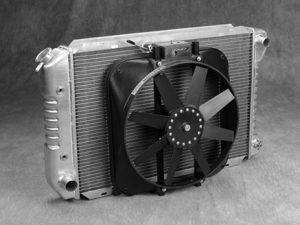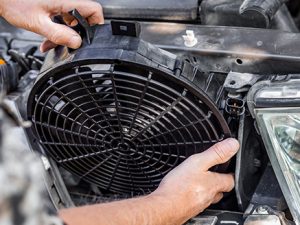Table of Contents
- Understanding the Function of Radiator Fans
- How Radiator Fans Work
- Types of Radiator Fans
- Maintenance of Radiator Fans
- Common Problems with Radiator Fans
A car’s radiator system is a vital part of keeping the engine cool and preventing it from overheating. While many people are familiar with the radiator itself, the role of the radiator fan is just as crucial, yet often overlooked. Radiator fans play an essential role in ensuring your vehicle’s cooling system operates efficiently, especially under heavy load or at low speeds when airflow around the radiator is insufficient.
In this article, we will explore the function of radiator fans, the different types available, and how to maintain them to keep your car’s cooling system in top condition.
Understanding the Function of Radiator Fans

The main role of the radiator fan is to regulate the temperature of the engine by enhancing the radiator’s ability to dissipate heat. The fan is typically located behind or in front of the radiator and helps increase airflow when the vehicle is stationary or moving at low speeds.
How Radiator Fans Work
When the engine is running, it generates a large amount of heat, which is absorbed by the coolant. The coolant travels through the radiator, where the heat is transferred to the air. However, when the car is idle, there is not enough airflow to cool the radiator effectively. This is where the radiator fan comes in.
- When the engine temperature rises: The radiator fan kicks in to force air through the radiator, cooling the coolant and, in turn, lowering the engine temperature.
- When the engine cools down: Once the engine reaches an optimal temperature, the fan automatically turns off or slows down to conserve energy.
The radiator fan ensures that the engine does not overheat, which could result in damage to engine components and, in extreme cases, cause the engine to seize up.
Types of Radiator Fans
There are several types of radiator fans used in modern vehicles. The most common types include:
1. Mechanical Radiator Fans
Mechanical fans are driven directly by the engine’s crankshaft via a belt or fan clutch. These fans are generally found in older vehicle models but can still be seen in some trucks and larger vehicles. They work continuously while the engine is running, but their speed is regulated by the fan clutch.
- Advantages: Simple design, low maintenance.
- Disadvantages: Less energy-efficient, operates constantly, which can result in unnecessary power loss and fuel consumption.
2. Electric Radiator Fans
Electric fans are powered by an electric motor and are typically used in modern vehicles. They are more efficient than mechanical fans, as they only operate when necessary.
- Advantages: More energy-efficient, operates only when needed, less mechanical load on the engine.
- Disadvantages: Higher initial cost, more components that can fail (e.g., motor, sensors, or wiring).
3. Dual-Fan Systems
Some vehicles, especially those with larger engines, use dual-fan systems, which consist of two electric fans for greater cooling efficiency. These are commonly used in high-performance cars or vehicles with large radiators.
- Advantages: Better cooling capacity, improved airflow for large engines.
- Disadvantages: More expensive, higher power consumption.
4. Viscous Coupling Fans
This type of fan uses a viscous fluid to control the fan’s speed. The fan clutch contains a silicone fluid that responds to engine temperature. As the engine heats up, the fluid becomes more viscous, causing the fan to spin faster and increase airflow. When the engine cools down, the fluid becomes less viscous, and the fan slows down.
- Advantages: Automatic adjustment of fan speed, quieter operation.
- Disadvantages: Higher complexity, potential for fluid leakage over time.
Maintenance of Radiator Fans

Proper maintenance of radiator fans is essential to ensure that your vehicle’s cooling system works efficiently and to extend the life of the radiator fan itself. Here are some critical steps for maintaining radiator fans:
1. Regularly Inspect the Fan
Check the fan regularly for any visible signs of wear, damage, or debris. Look for:
- Cracked or damaged fan blades
- Loose or disconnected wiring
- Debris obstructing airflow
Ensure that the fan is securely mounted, and there are no obstructions blocking the airflow through the radiator.
2. Check the Electrical Components
For electric radiator fans, check the fan’s motor, wiring, and electrical connections. A malfunction in any of these components can cause the fan to fail. You can check the fan motor’s functionality by turning on the engine and observing the fan’s behavior. If the fan does not turn on, the issue might be with the motor or a blown fuse.
3. Test the Fan Clutch
For mechanical fans with a fan clutch, check if the fan clutch is functioning correctly. The fan clutch should allow the fan to spin freely when the engine is cold and engage when the engine reaches a certain temperature. If the fan spins freely at all times, or if it’s always engaged, the fan clutch may be faulty.
4. Clean the Radiator and Fan Blades
Debris such as dirt, leaves, and insects can accumulate on the radiator and fan blades, blocking airflow and reducing cooling efficiency. Regularly clean the radiator fins and fan blades with compressed air or a soft brush. Be careful not to damage the delicate fins of the radiator.
5. Ensure Proper Coolant Levels
A well-functioning radiator fan is crucial, but the engine’s coolant levels should also be maintained properly. Low coolant levels can reduce the effectiveness of the cooling system and lead to overheating. Regularly check coolant levels and top up if necessary, especially before long trips.
Common Problems with Radiator Fans
Like any mechanical or electrical component, radiator fans are subject to wear and tear. Below are some common problems with radiator fans:
| Problem | Cause | Solution |
|---|---|---|
| Fan not turning on | Faulty motor, blown fuse, or damaged wiring | Inspect the motor and wiring, replace the fuse if needed |
| Fan runs continuously | Sticking fan clutch or faulty electric fan sensor | Replace the faulty fan clutch or electric fan sensor |
| Weak airflow | Blocked fan blades, broken fan blades, or debris in the radiator | Clean or replace the fan blades, remove any debris |
| Excessive noise | Worn-out fan bearings or broken fan blades | Replace the fan bearings or fan blades |
| Engine overheating | Radiator fan not functioning properly | Test and repair the fan, check coolant levels |
Conclusion
Radiator fans are a crucial component of your vehicle’s cooling system, working tirelessly to ensure the engine doesn’t overheat. Regular inspection, maintenance, and timely repairs can ensure the radiator fan continues to operate efficiently and prevents costly damage to the engine. Whether you have an electric fan, mechanical fan, or dual-fan system, understanding the function of the radiator fan and keeping it in optimal condition will ensure a longer lifespan for both the fan and your engine.
By following a routine maintenance schedule and addressing common issues promptly, you’ll help ensure that your vehicle remains cool, even during the hottest conditions.